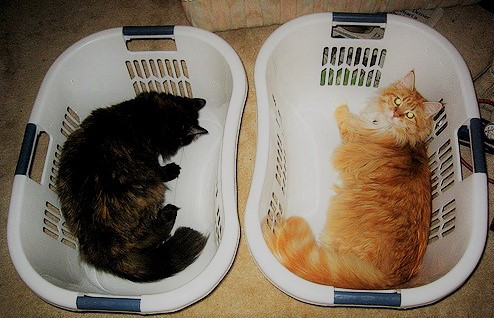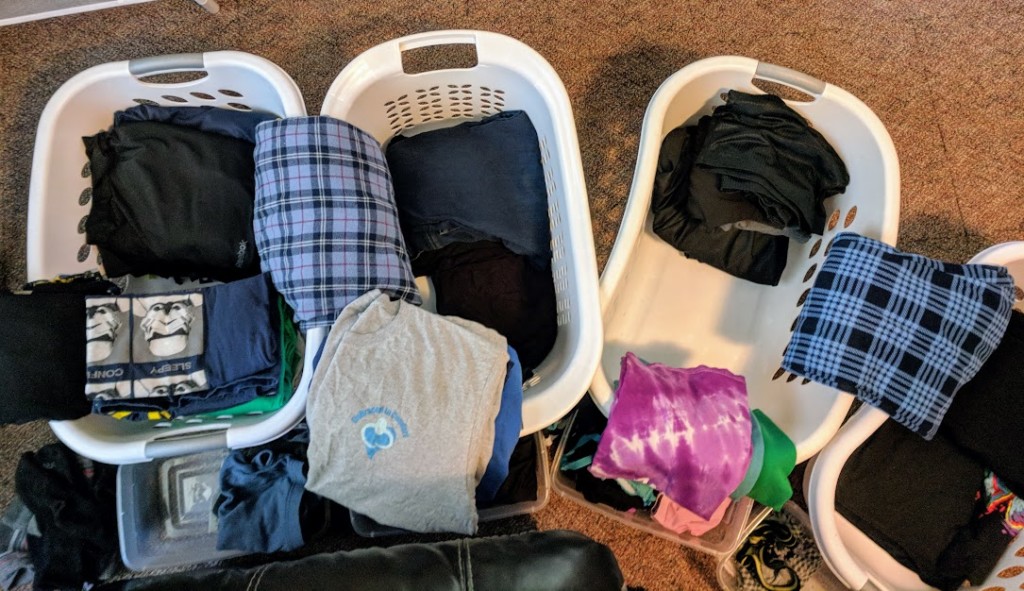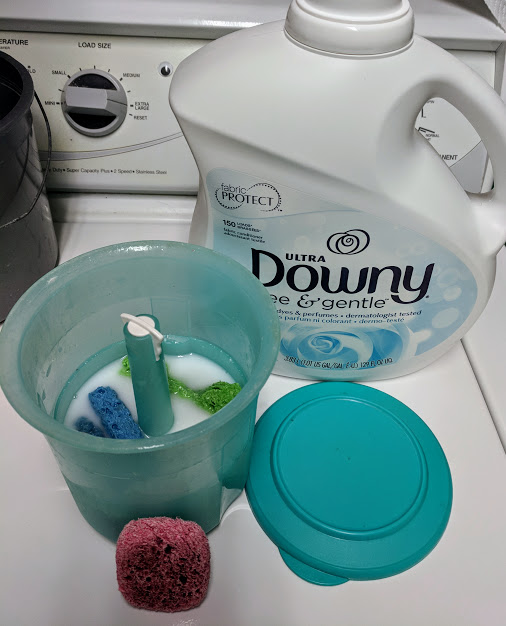When my husband and I were still dating, he made it clear to me – he would cook, do dishes, scrub toilets, and just about anything else I put on a list for him, but he did NOT like doing laundry. That was okay with me – I’d take laundry over toilets and dishes any day. The division of labor we have has worked well for over 20 years, and I’ve worked hard to hone my laundry technique so that I can get through the family’s laundry in a short part of my weekend.
In my job as an entrepreneur and process engineer, I am always looking for ways to apply the best practices from the manufacturing floor to my jobs at home. I’ve tried many different processes, but I feel I’ve finally honed the technique into one that might help other moms who are flattened under a pile of this unwanted chore.

Principle #1: Handle clothing as little as possible ::
My son has been collecting laundry for me for a very long time. I started him young and it’s one of his weekly chores. So, get the kids to help when at all possible. After he delivers the laundry to the laundry room, I sort it DIRECTLY INTO THE WASHER. I grab the darks out and load them into the washer and throw the lights into a separate basket. Most of these are lightly soiled, so I wash on cold to save money on hot water. After the load comes out of the dryer, I put it into a basket and take it to my folding/sorting area. For me, that’s in front of a TV, where I can watch episodes of my favorite shows while folding. The BEST way, however, would be to take each piece directly out of the dryer, fold it, and put it into the correct basket, but I don’t have room for this in my laundry room. So, I transfer it. Then, I fold the pieces and put them right into the family member’s basket, grouping with like items in that basket. A small shoe box in front of each basket can hold underwear and socks. Less sorting and less handling will save a lot of time.

Principle #2: Define your processes and train your crew ::
My family knows that dirty laundry goes in their baskets. Their rooms might look like disaster zones, but the dirty clothes go into the baskets. I pick my battles. Also, I have a basket both upstairs and downstairs for what I affectionately call the “gross laundry”. This includes rags, wet towels, sweaty clothes, or anything else that needs to be sanitized. The family knows that anything “questionable” goes in there. If I find gross laundry with the regular, nobody is happy. They also know that stained items get set directly on the washing machine. This doesn’t always work with smaller children, but if you keep training them on the routine, the teenage years will be much easier. For instance, when my kids were littler, I would give each piece a look-over for stains before dropping it into the washer. I don’t have to do that now. When all the laundry is done and in each member’s basket, I put the hanging items on top of their basket, and they are all responsible to get their basket up the stairs and get the clothes put away. My daughter, in her teen years, has taken to “living” out of her basket all week, but, again, I pick my battles. Her dirty clothes are always in her hamper.
Principle #3: Use Quality and Affordable Raw Materials ::
Let’s talk detergent: I make my own, but I keep a jug of “All, Free and Clear” available just in case I don’t have time to make it. It’s my backup so that I don’t avoid doing laundry simply because I don’t have detergent made. I’ve been making this detergent for years and my clothes last a long time. It also saves me a lot of money. Here is how I make mine:
- Take a bar of Fells Naptha and grind up in a food processor until powdery. This needs a sturdy processor and it will sound as if the machine will explode, but it will soon settle down and turn it into a powder. It’ll probably give your blades a good scrub, too.
- Then I add 1 cup washing soda and 1/2 cup borax and and continue to let the food processor mix it up.
- I put this concoction in a canister in my laundry room. Then, I turn it into a liquid detergent by adding 8 teaspoons of the homemade powder to 8 cups of very hot water and mix it up a bit.
- You can let it sit overnight for best consistency, but I usually use it right away.
- I leave a teaspoon in the container with the powder and I use the same container for the liquid every time, marked to the 8 cup mark. That way, I don’t have to go and get measuring tools or measure out cups of water.
- I also add some essential oils – be sure to use a high quality, pure grade brand. I add about 5 drops of a purification oil to fight odor and 10 drops of orange oil to fight grime.
- After I turn the homemade powder into a liquid, I add a half cup of the liquid mixture to my washing machine as it is filling.
- *HINT: I also take a bar of Fells Naptha, rip the paper off the top, and use it to treat any tough stains. This is a miracle working bar. Just rub it against a damp stain, rub the fabric against itself, and watch the magic occur.

For all loads, I add a scoop of baking soda to the top of the clothing in the wash. For the light-colored loads, I put a scoop of oxy clean into the water as it is filling, before I add the clothes.
Now, for fabric softeners and dryer sheets. I do NOT recommend using traditional dryer sheets. The perfumes and ingredients are bad for your skin. My son was breaking out badly when he was younger and my pediatrician recommended stopping the use of all dryer sheets because it was like embedding fiberglass particles into your clothing. Yuck.
To fight static and make things soft, I take a container, fill it with water, add 1 cap full of Downy Free and Gentle and soak 5-10 half sponge pieces in there {just take simple sponges and cut them in half}. Every time I transfer a load to the dryer, I put a sopping wet sponge into the dryer and, voila, no static – and your wallet and skin will thank you because you can reuse those sponges infinitely!

So, there you have it – my crazy system. Now, you may have to modify it – if you have littles getting into your baskets, you might want to put the baskets on the kitchen table and stand up to fold. Just think of ways to eliminate multiple handling, multiple sorting, and other extra steps. You will be surprised how it all adds up in the end. And, never underestimate the allure of a pile of dirty clothes to adventurous toddlers. When my kids were little, I would create a huge mound and let the kids play in it until it was through the washer. Yes, it’s kinda gross to be playing in dirty laundry, but they survived. And, when the baskets are empty, those make fun vessels for all sorts of things – clothes basket race car race, anyone?
One final note: next year my daughter will be a senior in high school. And, even though I have a great system honed, I want her to learn to do her own laundry, so she will have that responsibility starting next year.
Sometimes we have to break our system and add a little inefficiency to the process so that our kids can reap the benefits. It’s just part of our job description! Happy laundering!














